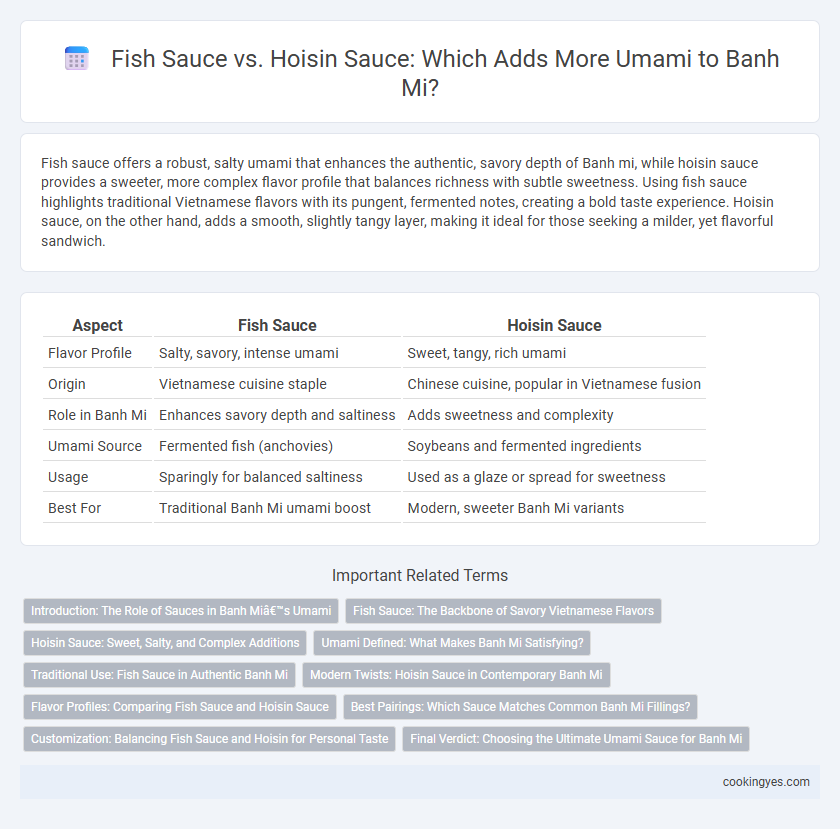Fish sauce offers a robust, salty umami that enhances the authentic, savory depth of Banh mi, while hoisin sauce provides a sweeter, more complex flavor profile that balances richness with subtle sweetness. Using fish sauce highlights traditional Vietnamese flavors with its pungent, fermented notes, creating a bold taste experience. Hoisin sauce, on the other hand, adds a smooth, slightly tangy layer, making it ideal for those seeking a milder, yet flavorful sandwich.
Table of Comparison
| Aspect | Fish Sauce | Hoisin Sauce |
|---|---|---|
| Flavor Profile | Salty, savory, intense umami | Sweet, tangy, rich umami |
| Origin | Vietnamese cuisine staple | Chinese cuisine, popular in Vietnamese fusion |
| Role in Banh Mi | Enhances savory depth and saltiness | Adds sweetness and complexity |
| Umami Source | Fermented fish (anchovies) | Soybeans and fermented ingredients |
| Usage | Sparingly for balanced saltiness | Used as a glaze or spread for sweetness |
| Best For | Traditional Banh Mi umami boost | Modern, sweeter Banh Mi variants |
Introduction: The Role of Sauces in Banh Mi’s Umami
Fish sauce delivers a potent umami foundation to Banh Mi through its rich fermented anchovy essence, enhancing savory depth and complexity. Hoisin sauce introduces a sweet, tangy, and slightly spicy note that balances the sandwich's flavors with a subtle umami sweetness. Together, these sauces create a harmonious blend that defines Banh Mi's iconic umami profile.
Fish Sauce: The Backbone of Savory Vietnamese Flavors
Fish sauce, with its rich umami profile derived from fermented anchovies, serves as the backbone of savory Vietnamese flavors in traditional banh mi. This essential condiment intensifies the sandwich's depth, imparting a salty, slightly sweet complexity that hoisin sauce cannot replicate. While hoisin sauce adds sweetness and a smoky aroma, fish sauce provides the authentic, robust savoriness critical to banh mi's distinctive taste.
Hoisin Sauce: Sweet, Salty, and Complex Additions
Hoisin sauce adds a sweet, salty, and complex umami layer to Banh Mi, balancing the sandwich's savory elements with its rich, slightly tangy flavor profile. Unlike fish sauce, which provides a sharp, briny depth, hoisin sauce contributes a thick, molasses-like texture that enhances the overall taste experience. This complexity makes hoisin sauce a popular choice for those seeking a subtler, more rounded umami boost in traditional Vietnamese Banh Mi recipes.
Umami Defined: What Makes Banh Mi Satisfying?
Fish sauce delivers a rich, savory umami profile in Banh Mi through its fermented anchovies, intensifying the sandwich's depth with salty, oceanic notes. Hoisin sauce adds a sweet, tangy umami layer, balancing flavors with molasses and fermented soybeans. Combining these sauces enhances Banh Mi's complex umami, making each bite satisfying with a harmony of salty, sweet, and savory tastes.
Traditional Use: Fish Sauce in Authentic Banh Mi
Fish sauce is a fundamental ingredient in traditional Banh Mi, delivering a deep umami flavor that authentically represents Vietnamese cuisine. Its fermented anchovy base adds a savory, slightly salty complexity that distinguishes classic Banh Mi from variations using hoisin sauce. While hoisin sauce introduces sweetness and a thicker texture, fish sauce preserves the genuine taste profile cherished in authentic Banh Mi recipes.
Modern Twists: Hoisin Sauce in Contemporary Banh Mi
Hoisin sauce introduces a sweeter, caramelized umami dimension to modern Banh Mi, contrasting with the traditional salty, fermented depth of fish sauce. Contemporary Banh Mi recipes often blend hoisin sauce for a balanced umami profile that appeals to diverse palates and highlights innovative flavor layering. This modern twist enhances the sandwich's complexity while maintaining its authentic Vietnamese roots.
Flavor Profiles: Comparing Fish Sauce and Hoisin Sauce
Fish sauce delivers a salty, savory umami punch with fermented anchovy depth that enhances the traditional Banh Mi's flavor complexity. Hoisin sauce offers a sweeter, tangy profile with soy and garlic notes that balance the sandwich's fresh herbs and pickled vegetables. Choosing between fish sauce and hoisin sauce shapes the Banh Mi's umami character, emphasizing either bold saltiness or rich sweetness.
Best Pairings: Which Sauce Matches Common Banh Mi Fillings?
Fish sauce offers a salty, savory umami depth that complements traditional Banh Mi fillings such as grilled pork, pate, and pickled vegetables by enhancing their natural flavors. Hoisin sauce brings a sweeter, richer profile that pairs exceptionally well with roasted meats and tofu, balancing savory and sweet elements in the sandwich. Choosing the right sauce depends on the specific filling: fish sauce elevates lighter, protein-rich meats while hoisin sauce harmonizes with robust, caramelized ingredients.
Customization: Balancing Fish Sauce and Hoisin for Personal Taste
Balancing fish sauce and hoisin sauce in Banh Mi enhances umami through customization, allowing individuals to tailor flavor intensity from salty, savory notes of fish sauce to the sweet, rich profile of hoisin. Tuning the ratio of these sauces adapts the sandwich to personal taste preferences, optimizing the balance between pungency and sweetness for a unique umami experience. Experimenting with proportions ensures the distinct Vietnamese Banh Mi flavor aligns perfectly with individual palate desires.
Final Verdict: Choosing the Ultimate Umami Sauce for Banh Mi
Fish sauce delivers a complex umami depth with its savory, salty profile essential to authentic Banh Mi, enhancing the grilled meats and pickled vegetables. Hoisin sauce offers a sweeter, richer flavor that balances spiciness and adds a subtle caramelized finish, popular in modern Banh Mi variations. For the ultimate umami experience, fish sauce remains the definitive choice due to its ability to intensify traditional Vietnamese flavors without overpowering the sandwich's delicate balance.
Fish sauce vs hoisin sauce for Banh mi umami Infographic

 cookingyes.com
cookingyes.com